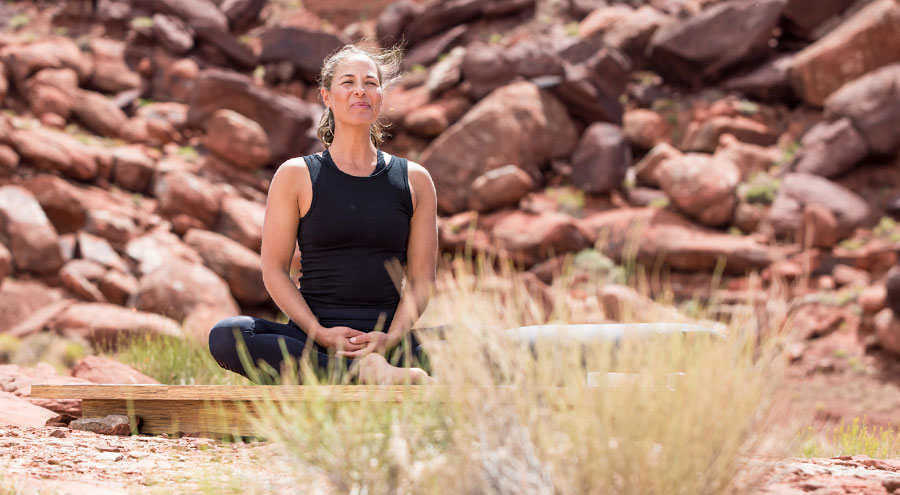
Every living being breathes. This includes all animals—even single-celled ones—and all plant life. Human beings take an average of 23,000 breaths each day. Our breath is, quite literally, the most important physiological function keeping us alive. How we breathe—the rhythm, depth, rate, etc.—directly affects our nervous system. It is a key factor in maintaining health throughout our lives. Breathing is so important that it is the only physiological process that we can control. But it also happens all day long, every day, without our having to think about it. Pranayama, the fourth limb of yoga, is the practice of refining our breathing to support body-mind balance.
In the eight-limbed system, pranayama sits at the intersection between the more worldly, physical practices and those that develop the mind. The way we breathe affects our state of mind, and also is indicative of our state of mind. When we are in a state of calm, our breathing is usually slow and even. When we are agitated, our breathing is often shallow or rough. Intentionally deepening and slowing our breath can begin to calm an agitated mind.
The word pranayama comes from two Sanskrit words: prana (life force) and ayama (expansion). Many of the pranayama practices aim to control the flow of the breath, and to bring balance to the body and mind through calming, energizing, heating and cooling the nervous system. Because breathing is so intimately integrated with the nervous system and our mental state, pranayama is a very powerful practice. It’s so powerful that it’s important to work with an experienced teacher in order to ensure that your practice is healthy and safe.
Pranayama and the Natural Breath
As a longtime student of Donna Farhi’s, I subscribe to the idea that uncovering your natural breathing pattern is the best place to start. Many of us have learned to breathe in ways that are not necessarily healthy. Dysfunctional patterns such as chest breathing, collapsed breathing, hyperventilation and reverse breathing can create underlying obstacles to practicing pranayama. Rather than layering breathing techniques on top of a possibly dysfunctional breathing pattern, it’s important to refine our natural patterns before we practice pranayama.
Donna Farhi’s The Breathing Book is a great resource for learning more about breathing patterns and their specific effects on our body-mind. Here’s a simple inquiry that you can practice in order to get in touch with your own breathing pattern:
- Lie on your back on a yoga mat in Constructive Rest Position (knees bent with the soles of your feet on the floor).
- Make sure that your head is not tilting back. If it is, place a small pillow or folded yoga blanket underneath your head and neck.
- Without trying to breathe any particular way, feel your body breathing. Where in your torso do you feel the expansion of the inhalation? Does your chest expand while your abdomen contracts (chest breathing)? Does your abdomen expand, along with your ribcage when you inhale? What happens when you exhale? Does your abdomen expand (chest or reverse breathing)? Or does it contract?
Breathing patterns are not so easy to change. Think about it: 23,000 breaths per day for how many days and years? These patterns can be stubborn. But we can change them, with patience, of course. Again, working with an experienced teacher is crucial.
Pranayama Techniques for Everyone
There are a few pranayama practices that are likely healthy for anyone. These include Nadi Shodhana (Alternate Nostril Breathing) and practices where we intentionally lengthen the inhalation or exhalation. We just need to make sure that our baseline is healthy abdominal breathing. This means that the abdomen and ribcage expand on the inhalation and contract on the exhalation.
I won’t elaborate on these practices in this post because, again, I encourage you to learn them in real time with a teacher. (Have I mentioned this before?)
Asana and Pranayama Together
Pranayama is actually an equal partner in the practice of Hatha Yoga. While we often emphasize postures, it’s important to remember that how we breathe in our yoga poses determines the benefits—or possible hazards—of our practice. Here are a few suggestions:
- Make sure your breathing is free and relaxed. If your expression of an asana is restricting your breathing, back off and do less. Healthy breathing is way more important than going to your limit. Practice at your “intelligent edge.”
- Partner with your breath. In every single pose—if given the opportunity—your body will oscillate in harmony with the breath. Every breath has a retractive phase, either on the inhalation or the exhalation, and a deepening phase, either on the inhalation or the exhalation. This means that either the inhalation will ask your body to retract a bit out of the pose, or to deepen into the pose. Same is true for the exhalation. (Whether it’s the inhalation or exhalation that promotes retraction or deepening differs in different poses.)
How to Practice Partnering with the Breath
In Paschimottanasana (Seated Forward Bend), try this:
- Sit in Seated Forward Bend Pose, and bend forward only to the point where you begin to feel a mild stretch. Feel free to bend your knees so that it’s easier to relax forward.
- Now inhale deeply into your back. Do you feel your torso lifting away from the legs as you inhale? What do you feel as you exhale?
- In my body, the inhalation causes my body to retract (to lift up away from the legs) and the exhalation causes my body to soften closer to the legs. What is true for your body?
We can practice this way in every single pose. Coordinating the breath movement with the unfolding of each pose melds asana and pranayama together, connecting body and mind in every moment of our practice.
